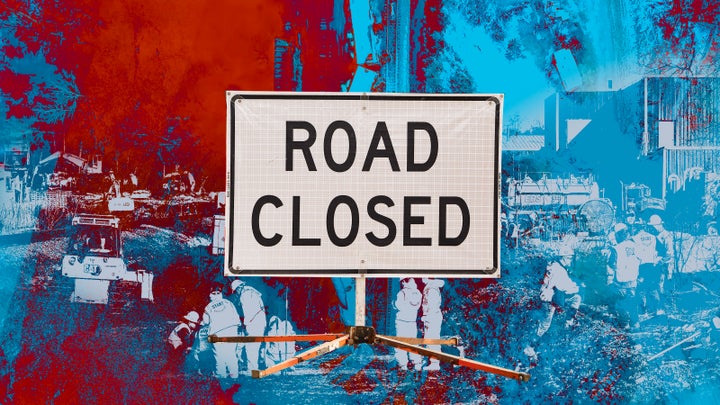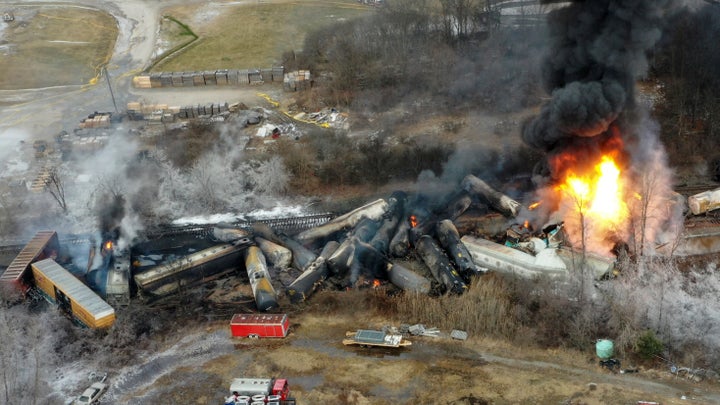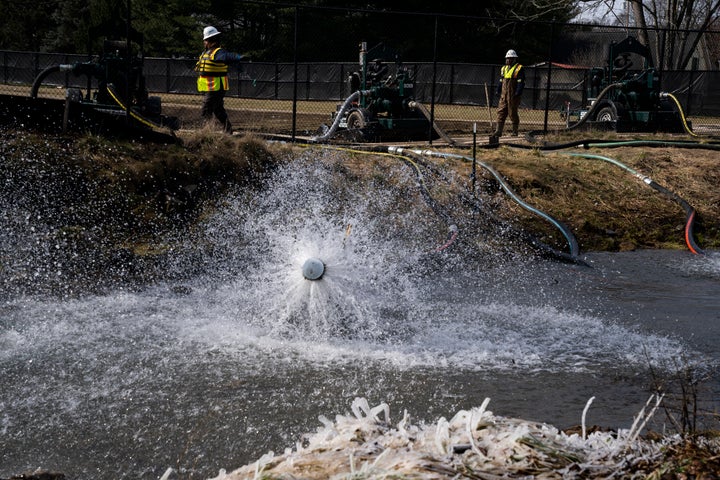
Two weeks after the fiery derailment of a Norfolk Southern train hauling toxic chemicals, U.S. Environmental Protection Agency Administrator Michael Regan traveled to the rural town of East Palestine, Ohio, and urged area residents to “trust the government.”
“I know that’s hard. We know there’s a lack of trust,” Regan said during a Feb. 17 visit. “We’re testing for everything that was on that train.”
Securing public trust in such a conservative town and state was always going to be an uphill battle for the Biden administration. Ohio Republicans didn’t do the administration any favors, quickly and repeatedly condemning the federal response while applauding Republican Gov. Mike DeWine and state agencies despite their own missteps.
Public trust has only continued to crumble since Regan’s initial visit — especially when it became evident that responders weren’t initially testing for all hazardous materials on the train after all. Many area residents have been clear about their lack of confidence that officials have been transparent about current and future health and environmental risks.
“I don’t believe the government or railway company’s claims that our town is safe,” Greg Mascher, a village resident, wrote in a recent op-ed in The Guardian. “You hate to say that they’re lying, but they are.”
As authorities assured the community that the air and water were safe, residents and responders reported numerous symptoms, from sore throats and coughing to bloody noses and rashes.
The U.S. EPA and Ohio EPA, an unaffiliated state agency, have repeatedly stressed that they are supervising and overseeing the disaster response — namely, monitoring for toxic chemicals in the environment.
One of the primary concerns is exposure to dioxins, an extremely toxic class of chemicals thought to have been released into the environment when hundreds of thousands of pounds of vinyl chloride, a common organic chemical used in the production of plastics, were intentionally burned to prevent a potential explosion. Dioxins are linked to numerous serious and potentially deadly health problems, including cancer, developmental and reproductive problems, immune system damage and hormone disruption.

On its website, Ohio EPA has published videos of agency officials collecting water samples and emphasizing the importance of ensuring their integrity. The U.S. EPA has promised to “immediately step in, conduct the necessary work, and then force Norfolk Southern to pay triple the cost” if the railroad’s cleanup activities fall short of EPA standards.
Yet two months after the disaster, amid mounting distrust and as lawsuits pile up against Norfolk Southern, the railroad giant maintains an outsize role in monitoring for contamination in and around East Palestine. Contractors on Norfolk Southern’s payroll — including one with a particularly checkered past — are leading the search for pollutants in water, soil and home air.
Several independent experts have condemned the testing to date as inadequate, pointing out that authorities have been slow to test for the full spectrum of potential contaminants. Critics have unsurprisingly compared Norfolk Southern’s involvement to a fox guarding the henhouse, and some argue that funding cuts at environmental agencies opened the door for Norfolk Southern to be heavily involved in studying its own chemical disaster.
Nicole Karn, a chemist and associate professor at the Ohio State University, called the chemical screening and reporting “sloppy” and “ridiculous.”
“In terms of trust, it would be helpful if the company responsible for the problem wouldn’t be in charge of cleanup,” she told HuffPost.
Andrew Whelton, an environmental engineer and professor at Purdue University, has investigated chemical risks in the wake of numerous industrial disasters. He said it is not uncommon for a responsible company to be involved in data collection after a spill or accident.
“What is uncommon,” he said, “is deferring to the party responsible for causing the injuries to inform how government agencies will make public health and safety decisions that pertain to acute, immediate health risks.”
‘There Needs To Be Somebody Running Point’
The response in East Palestine involves a small army of government agencies — the U.S. and Ohio EPAs, as well as the Columbiana County Health District — and railroad contractors operating in different bubbles with a patchwork of chemical testing regimes.
Whelton, who is leading an independent research team in East Palestine, has highlighted those inconsistencies in community presentations and social media posts. He says a big issue with the response is that no one is ensuring all agencies and private contractors are looking for the same contaminants.
“The distrust happened because officials did not understand the complexity of the disaster that they encountered,” he said. “They made a lot of decisions that were incorrect, they didn’t have the data to make the statements they made. And it turns out that when you look closely at the data they collected, many of the agencies were running in different directions and not testing for what they need to test for.”
For example, the U.S. EPA detected elevated levels of acrolein — a highly toxic substance found in smoke and a known respiratory irritant — in the air in East Palestine. But the state and railroad contractors have yet to test for it in drinking water or streams.
Whelton said that in his experience, such disorganization is “endemic to disaster response in the United States.”
“There needs to be somebody running point on this and providing the incident commander and the decision makers a big-picture perspective,” he said. “All the parties involved are operating in silos, even though they’re in the same room under unified command.”
Although the U.S. EPA is overseeing the cleanup in East Palestine, Whelton argues that government agencies charged with protecting public health and safety have effectively outsourced their responsibility to Norfolk Southern: The railroad giant is part of the “unified command” response team and its contractors have been allowed to craft chemical testing protocols that environmental regulators subsequently sign off on.
As HuffPost reported in mid-February, Ohio officials relied exclusively on a railroad contractor’s flawed water sampling to initially declare the village’s municipal water safe to drink. That contractor, Dallas-based consulting firm AECOM, told HuffPost at the time that it had followed a sampling plan designed by local health and safety agencies. It turns out that the sampling plan, which HuffPost obtained last month via a public records request, was not the work of state and local officials, but rather developed by AECOM on behalf of its client Norfolk Southern.
The railroad-funded sampling plan also did not initially call for testing for some of the hazardous materials that had been on the train, including chemicals 2-Butoxyethanol and isobutylene.

2-Butoxyethanol, also known as ethylene glycol monobutyl ether, is a colorless liquid commonly found in paint thinners, degreasers and silicone caulk. Exposure to the chemical is known to cause eye and nose irritation, headaches and vomiting. Isobutylene is a highly flammable gas used to make rubber, plastics and aviation fuel, and inhalation can cause dizziness, nausea, vomiting and unconsciousness.
By the time AECOM had developed its plan and started testing municipal and private well water, alarming levels of 2-Butoxyethanol were turning up in creeks and other surface water near the derailment site. A sample collected the day after the derailment from Sulfur Run, a stream that runs through the heart of East Palestine, detected the chemical at 312 parts per million. Surface water samples collected closer to the derailment site on Feb. 9 and 10 detected levels as high as 848 parts per million.
The workplace exposure limit is 50 parts per million in air for an 8-hour work day. At 700 ppm in air, 2-Butoxyethanol becomes immediately dangerous to life and health, according to the Centers for Disease Control and Prevention. To remove chemicals from area creeks, contractors have used aeration devices that Whelton says essentially force those toxins into the air and create a chemical exposure risk.
AECOM’s plan seemingly set the stage for a deficient, disjointed sampling effort. The Ohio EPA stepped in to begin its own sampling of the East Palestine municipal water system on Feb. 21, but did not test for 2-Butoxyethanol in drinking water until March 7, according to HuffPost’s review of lab reports. AECOM and the Columbiana County Health District first tested for it on Feb. 28 and March 13, respectively.
Laura Fauss, the public information officer for the Columbiana County General Health District, told HuffPost that her department has followed the AECOM plan while performing its own testing. She called the plan a “living document” that was subsequently revised to include 2-Butoxyethanol and other chemicals of concern, and was reviewed by Ohio EPA and other members of unified command. (HuffPost has been unable to obtain an updated version of the sampling plan.)
“I can’t speak to why it wasn’t in there the first round,” she said of 2-Butoxyethanol.

Jason Marshall, a spokesman for AECOM, did not address several of HuffPost’s specific questions or comment on the record about his previous inaccurate statement that government agencies created the sampling protocol.
“Following the events of February 3, 2023, AECOM was urgently engaged by Norfolk Southern to collect municipal and private potable water samples for testing and analysis by one of Norfolk Southern’s laboratory partners,” he said in an email statement. “The Potable Water Sampling Plan was developed in response to Norfolk Southern’s request for our services in accordance with prevailing industry standards and in coordination with the Ohio EPA, Ohio Division of Health and the Columbiana County Health District.”
AECOM, which developed the potable water sampling plan, is no longer involved in the East Palestine response, according to the company’s spokesman. Stantec, a Canadian consulting and engineering firm, replaced AECOM and took over drinking water testing in early March. It is not clear if Stantec is utilizing AECOM’s plan.
Ohio EPA, which has promised transparency in the wake of the disaster, did not respond to multiple requests for comment.
“I can commit to East Palestine that Governor DeWine and his cabinet will always tell you exactly what we know, what we don’t know yet, and what we are doing to find answers for the Village of East Palestine,” Ohio EPA Director Anne Vogel said during a March 28 congressional hearing on the derailment.
When confronted about what information the state had when it declared the town’s water safe, Vogel and DeWine have both provided dodgy, if not outright misleading, answers.
‘Paid To Say Everything’s OK’
Further undermining the cleanup are the many perceived conflicts of interest. At least four companies on Norfolk Southern’s payroll are currently involved in the search for contamination. The railroad, of course, has a vested interest in minimizing its own liability.
The Center for Toxicology and Environmental Health, known commonly by its acronym CTEH, is testing air quality in East Palestine homes and designed the air sampling protocol. The U.S. EPA, which took control of the derailment response on Feb. 21, reviewed and approved CTEH’s plan, ProPublica reported.
But independent experts told ProPublica that the air testing is inadequate to protect public health, in part because CTEH is not sampling for the full spectrum of chemicals involved in the accident.
CTEH has a long, controversial history of working for corporate giants in the wake of disasters, including oil company BP following the Deepwater Horizon spill, and of downplaying associated health risks. A toxicologist told The New York Times in 2010 that CTEH is “paid to say everything’s OK.”
CTEH was once more direct about the services it could offer clients. In language that has since been deleted from its website, CTEH “explained how the data it gathers about toxic chemicals can be used later to shield its clients from liability in cases brought by people who say they were harmed,” ProPublica reported.
CTEH is also testing surface water in and around the derailment site. Its parent company, Montrose Environmental Group, also owns Environmental Standards, Inc., a consulting firm that Norfolk Southern separately hired to assess a third-party lab’s reports on those samples.
Karn, the Ohio State professor, drew attention to that concerning relationship in post to Twitter: “[Norfolk Southern] is paying a company (CTEH, owned by Montrose) with a conflict of interest to collect samples, send those samples off to a lab (Pace, who can provide detailed reports) and then using Environmental Standards (owned by Montrose) to interpret those reports and obfuscate results.”
A separate railroad contractor, Arcadis, is the architect of a plan to test soil for dioxins and other chemicals. Independent experts told The Guardian that that plan is also flawed and “unlikely to give a complete picture” of contamination. More than 100 local and national organizations sent a letter to U.S. EPA leaders last month demanding independent dioxin testing.
“To date, Norfolk Southern has done an extremely poor job of building trust with the community of East Palestine and other communities impacted by the disaster,” the letter reads. “To ensure this testing is adequately conducted, and to rebuild public trust, we strongly recommend the U.S. EPA itself conduct the dioxin sampling or hire its own consultants to conduct the testing. Norfolk Southern should not be in charge of the dioxin sampling.”
The U.S. EPA added to the pile of potential conflicts of interest in East Palestine by hiring consulting firm Tetra Tech Inc. to prepare air monitoring reports and maps. A subsidiary of the company, Tetra Tech EC, is currently being sued by the Department of Justice over alleged false invoices for nuclear remediation work at Hunters Point Naval Shipyard in San Francisco. In 2018, two former Tetra Tech EC supervisors pleaded guilty and were sentenced to eight months in prison for falsifying soil samples as part of the cleanup.
Norfolk Southern and Tetra Tech Inc. have the same top two shareholders: The Vanguard Group and BlackRock.
The U.S. EPA did not respond to HuffPost’s requests for comment.
Many have condemned government agencies for deferring to companies on Norfolk Southern’s payroll. And some wonder if that arrangement isn’t a natural symptom of deep budget and staffing cuts at environmental agencies.
Funding Freefall
Since its creation in 1972, one of the core responsibilities of the Ohio EPA has been to monitor air, water and soil to ensure environmental standards are being met.
But its resources have dried up over the last two decades. Agency funding dropped more than 30% over a 20-year period, from approximately $302 million in 2003 to $207 million in 2022, when adjusted for inflation, according to an analysis from the Ohio Environmental Council, a statewide environmental advocacy organization. Staffing levels declined 14% from 2008 to 2018, and fines assessed for environmental penalties dropped 48% in 2018 when compared to the prior four-year average, The Columbus Dispatch found.
“It seems clear that the lack of legal authority as well as year-over-year funding reductions that the Ohio EPA has experienced really did contribute to Norfolk Southern playing an outsized role in a lot of the initial response decision-making,” Carol Kauffman, executive director of the Ohio Environmental Council, told HuffPost.
Many of those state-level reductions coincided with the exodus of some 1,200 employees from the U.S. EPA during the industry-friendly Trump administration.
“If we continue to defund agencies that are in place to keep us safe and protect our environment, they are going to be less equipped to do so,” Kauffman said, adding that a lack of investment fuels the sort of cycle of distrust that is on full display in East Palestine.
George Elmaraghy, a commissioner for the Ohio River Valley Water Sanitation Commission and former chief of Ohio EPA’s surface water division, applauded Ohio EPA’s disaster response and said Norfolk Southern needs to be responsible for long-term pollution monitoring. He said it is not unusual for a company to craft testing protocols and for government agencies to review those plans and supervise to ensure the cleanup is done right.
“That’s the way to do it,” he said. “The state does not have the capacity to deal with all this stuff at the same time. A state like Ohio has several spills going at the same time.”
David Michaels, a professor at George Washington University and former administrator of the Occupational Safety and Health Administration, argues the key to securing public trust during chemical spills and other disasters is for polluters like Norfolk Southern to foot the bill for testing and research — then “get out of the way.”
“The bottom line is that scientific investigation into the potential harms of products and activities should be paid for by producers of those products and activities,” he wrote in an opinion piece in Time magazine last month. “But the research should be planned, conducted, analyzed, and interpreted by independent scientists, not ones with financial conflicts of interest. Only then can we have confidence in the results.”
This article has been updated to clarify that the two former supervisors who were sentenced to prison worked for Tetra Tech EC, not its parent company Tetra Tech Inc.
